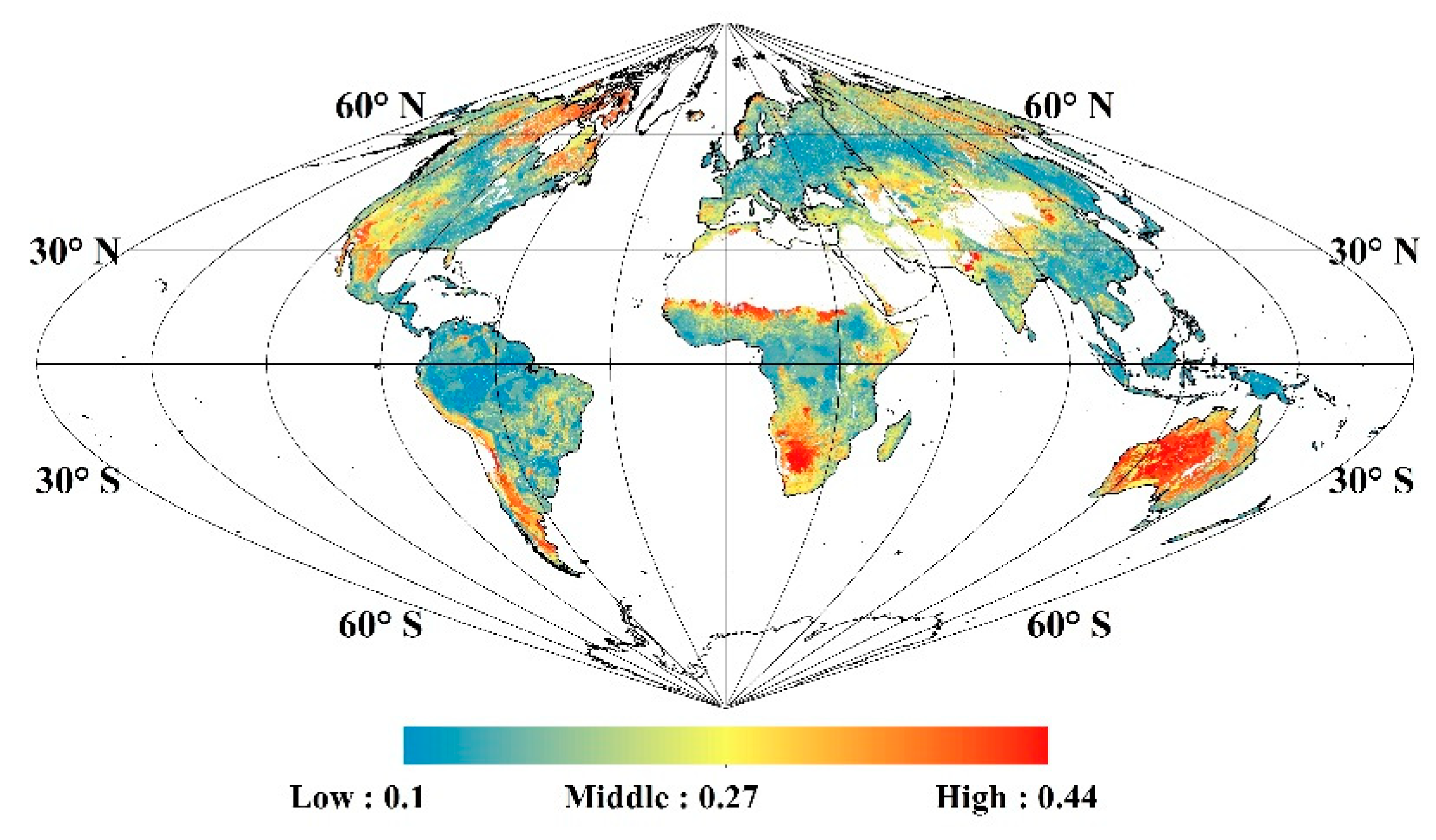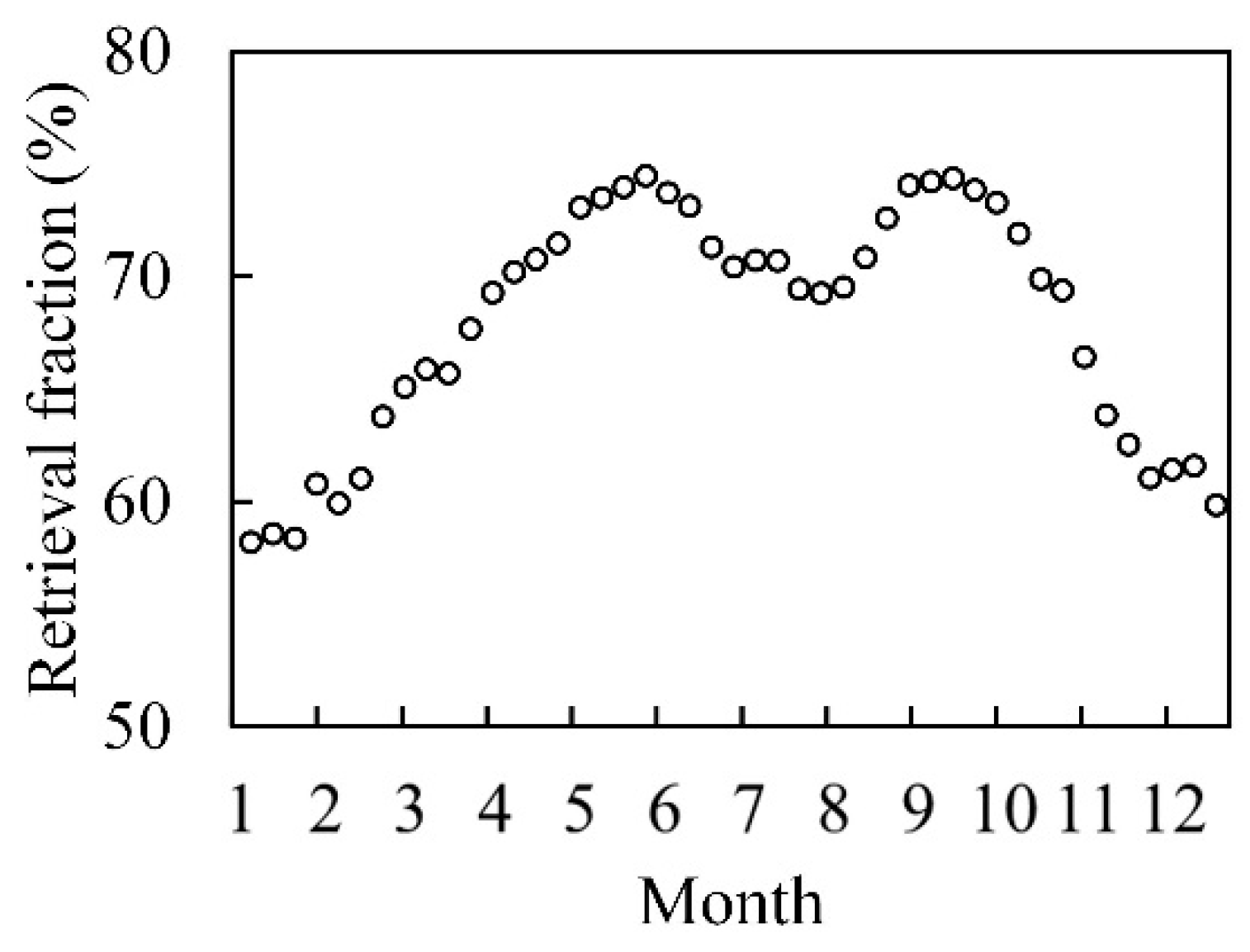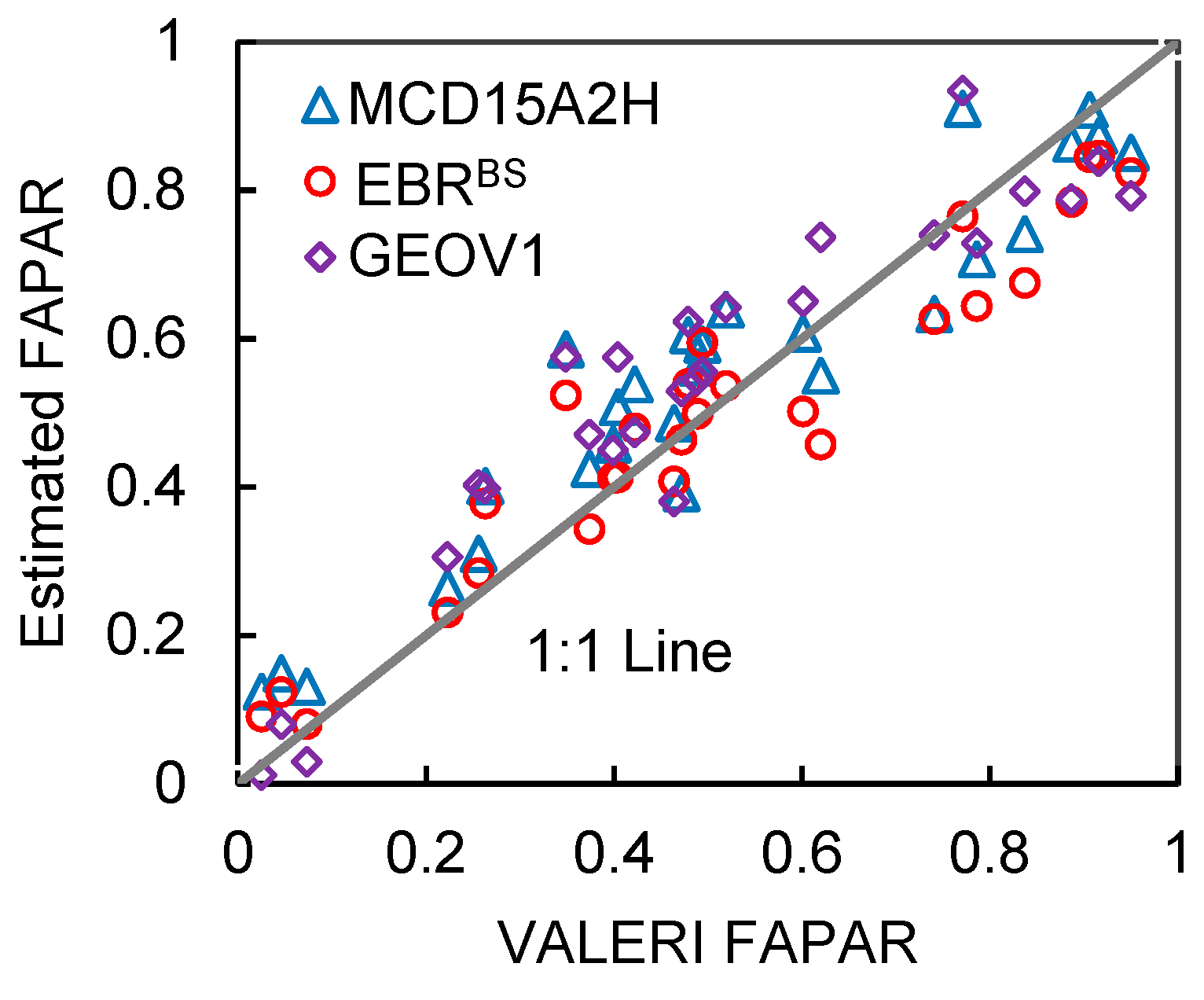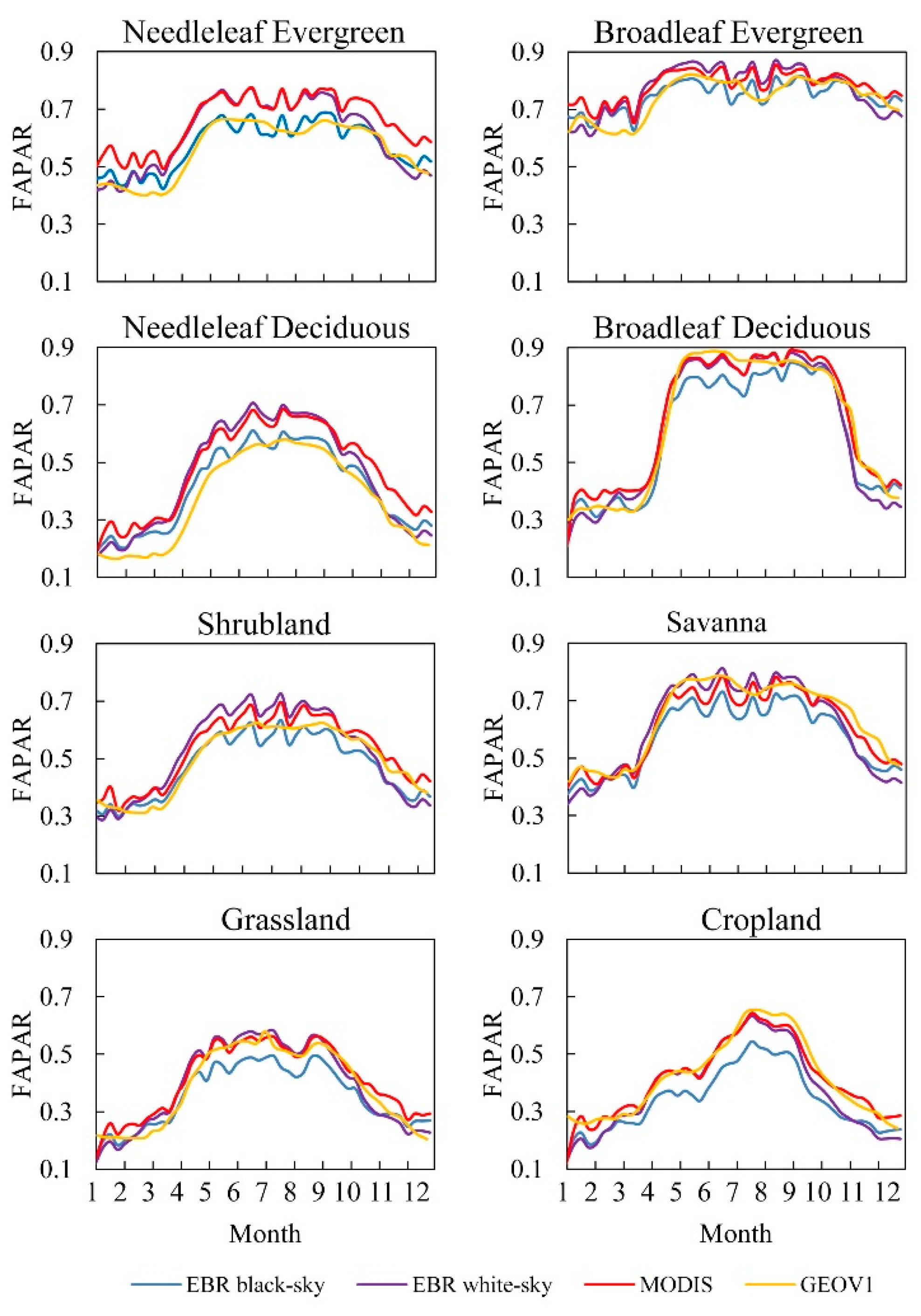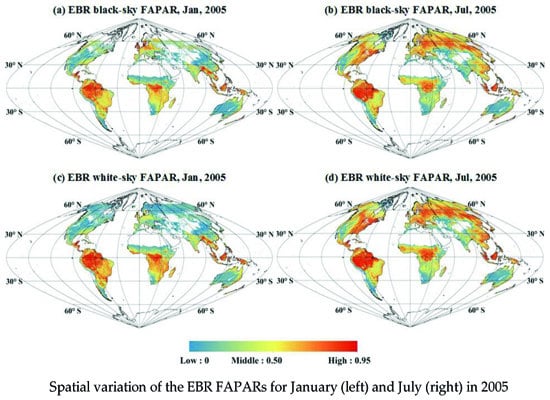Second, the energy balance residual method was employed to retrieve the white-sky and black-sky FAPAR products based on the MODIS VIS albedo, LAI, CI products, and also the above snow-free soil albedo data. In the EBR method, FAPAR equaled 1 minus the reflected fraction of PAR and the soil-absorbed fraction of PAR. The reflected fraction of PAR was directly provided by the MCD43A3 surface VIS albedo. The soil absorbed fraction of PAR was determined using the canopy transmittance and the retrieved soil VIS albedo using the NSM model. The canopy transmittance was calculated using the gap fraction model based on the MODIS LAI and CI products.
2.4.1. Estimating White-Sky and Black-Sky FAPAR Using the EBR Method
The PAR absorbed by the canopy,
, excludes the PAR reflected by the canopy and absorbed by the soil background, but includes the small part of PAR absorbed by the canopy after reflection from the underlying background. The energy budget in the soil–canopy–atmosphere structure is shown
Figure 2. According to the EBR method, the
can be calculated using Equation (1) [
5,
11,
57]:
where
and
are the canopy absorbed PAR and soil absorbed PAR, and
,
,
, and
are the incident PAR, outgoing PAR, transmitted PAR, and PAR reflected by soil substrate, respectively.
Therefore, FAPAR can be calculated as the ratio of
to
:
where
, the ratio of
to
, is the VIS albedo of the canopy, which can be directly determined from the MODIS BRDF product:
, the ratio of
to
, is the fraction of PAR absorbed by the soil background.
To obtain the canopy FAPAR, it is therefore necessary to derive the
, which can be derived if the canopy transmittance and VIS albedo of the soil background are available.
can be given by [
5,
58],
where
, the ratio of
to
, is the VIS albedo of the soil background, and
τ is the canopy transmittance.
The canopy directional transmittance,
, can be determined using the gap fraction model [
5,
59,
60],
where
is the leaf extinction coefficient,
is the projection of unit foliage area on the plane perpendicular to the sun incident direction
, LAI is the leaf area index,
CI is the clumping index, and
is the SZA. In this paper, the leaf angle distribution was assumed to be a spherical function with
= 0.5. The leaf extinction coefficient
can be determined using the leaf absorptance in the VIS band, which was set as 0.88 according to the simulations using the PROSPECT-5 model and also the measurements of the LOPEX’93 and ANGERS [
61].
If the soil background was assumed to be isotropic, the white-sky and black-sky FAPAR can be calculated using Equations (5) and (6):
where the superscript
represents black-sky and
represents white sky;
and
are the black-sky VIS surface albedo and white-sky VIS surface albedo, respectively, which can be directly derived from BRDF products, such as MCD43A3.
and
are the soil-absorbed fraction of PAR under white-sky and black-sky conditions, respectively, and can be determined using Equation (3).
In order to determine
, the canopy transmittance under white-sky conditions should be calculated by integrating the directional transmittance
over the whole hemisphere:
where
is the canopy transmittance under white-sky condition; other quantities are the same as for Equation (4).
Finally, the total FAPAR can be calculated using a linear combination of the black-sky FAPAR and white-sky FAPAR:
where
is the total FAPAR and
is the proportion of diffuse PAR.
2.4.2. Estimating Snow-Free Soil VIS Albedo Using the Non-Linear Spectral Mixture Model
In the EBR method, the key step is to estimate the VIS albedo of the soil background because the LAI and VIS albedo products are available as part of the MODIS products.
Many methods of analyzing remote sensing data assume that pixels are pure, and so a failure to accommodate mixed pixels may cause significant errors. The linear spectral mixture model, called the patch method, has been widely used to deal with mixed pixels, where each patch (or subpixel) acts independently of the other for the downwelling radiation. However, the linear spectral mixture model or patch method fails to describe mixed pixels for the coupled subpixels: for example, the vegetation canopy and soil background are normally non-linearly mixed due to light interception by the leaves within the upper canopy (see
Figure 3a,b).
In this paper, we employed the layer approach to describe the non-linear contribution of soil background and leaves within the upper canopy on the canopy albedo (
Figure 3b). The layer approach was used to account for the contribution of leaves within the upper canopy and soil substrate on the canopy albedo, which treats the upper canopy as semi-transparent for the radiation input [
62]. The transmitted PAR above the soil substrate can be determined using Beer’s law,
As illustrated in
Figure 3b, if all the leaf pixels in
Figure 3a were separated and re-ordered together at the upper part, while all the soil pixels were re-ordered at the lower part, a simplified non-linear spectral mixture (NSM) model can be designed to simulate the total canopy albedo by combining the albedo of the “pure” vegetation canopy with an
of 100% and soil albedo. For each coarse-resolution pixel, the TOC VIS albedo is approximated as a non-linear mixture of a “pure” vegetation sub-pixel (upper part in
Figure 3b with FVC of 100%) and a soil sub-pixel (lower part in
Figure 3b):
where
is the TOC VIS albedo,
is the fraction of vegetation cover,
is the TOC VIS albedo of a “pure” vegetation canopy with an
of 100%,
is the VIS albedo of the soil background, and
is the canopy downward transmittance when light is transferred from the TOC to the soil, as in Equation (7). In Equation (10), the canopy VIS albedo is simplified using a weighted mean of the “pure” vegetation subpixel and the soil subpixel; the weighting coefficient used for the soil subpixel is the canopy transmittance.
The TOC VIS albedo of “pure” vegetation can be approximated using that of dense vegetation. In this study, we analyzed the TOC VIS albedo for woody and herbaceous vegetation with different LAIs. The VIS albedo data is from the MCD43A3 product, the LAI data is from the MCD15A2H product, and the vegetation types were from the MCD12Q1 product. Only the MODIS products at peak growth stage (during the day of year (DOY) 209–217 in 2005 in the northern hemisphere) was used. For dense canopy, woody cover types, including needleleaf evergreen forest, broadleaf evergreen forest, needleleaf deciduous forest, broadleaf deciduous forest) have almost the same white-sky VIS albedo, while herbaceous vegetation types have a relative higher white-sky VIS albedo. The variations of the white-sky VIS albedo of woody and herbaceous vegetation types with different LAI are illustrated in
Figure 4. The VIS albedo decreased with increased LAI, and became quite stable when LAI was greater than four. Therefore, we assumed that the VIS albedo for pure vegetation can be represented by the VIS albedo for vegetation with a “saturated” LAI value (e.g., LAI = 6). So, the priori VIS albedo values of “pure” vegetation with an FVC of 100 were designated as 0.025 and 0.041 for white-sky albedo of woody and herbaceous vegetation types, and 0.020 and 0.036 for black-sky albedo, respectively, which is corresponding to the VIS albedo of a dense canopy with an LAI value of 6.
can also be calculated using the gap fraction model with a fixed SZA of 0° and a fixed leaf extinction coefficient of 1:
The canopy transmittance and
can, therefore, be determined using LAI and CI data. The VIS albedo of the soil background can then be retrieved using the NSM model:
Here, the TOC VIS albedo can be directly derived from the MCD43A3 BRDF products, and FVC and can be determined using Equations (11) and (7), respectively. In this paper, the soil substrate was assumed as isotropic, and only the white-sky albedo of soil substrate was calculated.
If the NSM model shown in Equation (12) was employed to retrieve the soil VIS albedo, the uncertainty for dense vegetation pixels would be very large. For example, the error in the canopy VIS albedo will be magnified by about 100 times for a vegetation canopy with an
of 0.9, because the denominator of Equation (12) is then about 0.01. In order to address this problem, the abnormal soil VIS albedos obtained using the NSM model were replaced by the prior values. These prior values of soil VIS albedo can be determined using the yearly composite values, or be approximated using empirical formulae based on the soil organic deposition and texture of the soil [
55]. The ECOCLIMAP (a global database of land surface parameters at 1 km resolution) uses an empirical equation to calculate soil reflectance, as given in Carrer et al. [
56],
where
is the sand fraction. The global sand fraction data are derived from the Harmonized World Soil Database (FAO/IIASA/ISRIC/ISSCAS/JRC, 2009). The prior soil VIS albedo was mapped using the ECOCLIMAP sand fraction data and the yearly maximum FVC values derived from the MODIS CI and MCD15A2H LAI products based on the gap fraction model (Equation (11)), as shown in
Figure 5.
In this study, if the retrieved soil VIS albedo value was smaller than 0.02 or greater than 0.3 (the two threshold values given in Myneni et al. [
3] and Equation (13)) for snow-free pixels with an FVC > 0.3, the pixels were marked as abnormal and their soil VIS albedo values were replaced either by the yearly composite value (if there were more than three valid retrievals within a year) or the prior values determined by substituting the sand fraction and FVC values in Equation (13).
The TOC VIS albedo of a “pure” vegetation canopy will increase greatly if it is covered by snow and the NSM model will then fail to estimate the VIS soil albedo. For pixels determined to be snow-covered by the MOD10A2 snow cover product, the canopy black-sky FAPAR was directly determined using the gap fraction method as used in Xiao et al. [
21], where the black-sky FAPAR was assumed equal to one minus the canopy directional transmittance (
) as Equation (4); then, the canopy diffuse transmittance,
, was calculated by integrating
over the whole hemisphere (as Equation (7)) to determine the white-sky FAPAR (
).
Furthermore, in some regions, such as boreal forest, the soil surface is typically covered by different understory species (including litter, moss, lichen, etc.). Such cases were not taken into account in the NSM model. We did not discriminate the understory vegetation from soil background, and the soil albedo was regarded as the understory albedo for the forest region.
However, there was no in situ dataset to validate the VIS albedo of soil substrate at 500 m resolution. So, the simulations by the PROSAIL model were treated as the “true” values to indirectly validate the NSM model and EBR method. Furthermore, in order to quantify the sensitivity of the NSM model and EBR method, a Gaussian random noise with a relative intensity of 0% to 30% was added to the canopy LAI values. One-thousand different random noises were added to each of the 81,000 simulated samples listed in
Table 4.




